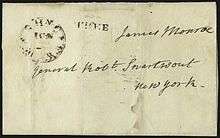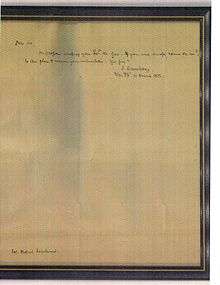Robert Swartwout
Brigadier General Robert Swartwout, (December 8, 1779 – July 17, 1848) was an American military officer, merchant, alderman, and Navy agent of New York City. He was born in Poughkeepsie, New York, the son of the American Revolutionary War military veteran Captain Abraham Swartwout and descendant of Tomys Swartwout
Brigadier General Robert Swartwout | |
|---|---|
| Born | December 8, 1779 Poughkeepsie, New York |
| Died | July 17, 1848 (aged 68) New York, New York |
| Years of service | 1812–1816 |
| Rank | Brigadier General |
Political alliances
Robert Swartwout was a loyal friend and supporter of Aaron Burr. He shot Richard Riker, a supporter of Alexander Hamilton in the leg in a duel on November 14, 1803.[1]
Early Life and Military career


Swartwout was born in Poughkeepsie, New York into a military and merchant family of Dutch ancestry. He was the second-born, and had ultimately four brothers and one sister. After finishing school, Swartwout intended to study at Columbia College. But as his family was highly indebted and could not afford to pay the tuition fees, he chose to join the military. He began his military career in the War of 1812 as militia colonel at New York Harbor from August to November 1812. He commanded the United States 4th Brigade in the campaign of 1813 on the St. Lawerence. Following the death of General Leonard Covington at the Battle of Chrysler's field, he was appointed Brigadier General and 9th Quartermaster General of the US Army on March 21, 1813, by President James Madison through Secretary of War John Armstrong. Later President James Monroe reappointed him Quartermaster General and he served in that capacity until June 5, 1816.[2]
War of 1812, Quartermaster General Swartwout dispatched the letter to Major General and later 9th President of the United States William Henry Harrison, June 2, 1813 announcing the American victory at the Second Battle of Sackett's Harbor on May 29, 1813.

Real estate, "Swartwout" New Jersey Meadowlands, and Banking
After the war, General Swartwout moved to New York City. He resumed his merchant career and acquired a charter on January 28, 1820 to start the New Jersey Salt Marsh Company with his brothers John and Samuel. They acquired several thousand acres between Newark and Hoboken for what was referred to as the "Swartwout" New Jersey Meadowlands and started the first large scale reclamation project to dike and drain the meadows for habitation and agriculture.[3]

New Jersey granted a charter for 15 years to Robert Swartwout and Charles Haines to establish the Hoboken Banking and Grazing Company in 1822, to issue stock for New Jersey Salt Marsh Company. They were authorized to erect one of the first banking houses and did so in Hoboken on 2nd street and Washington on Nov. 15, 1822 [4]
In 1818 General Swartwout was appointed as Naval agent for New York City, he also served in local politics as an alderman in Ward Five.
Family
On January 7, 1808, Robert married Margaret Bradford Dunscomb, in New York, NY. Together they had three daughters, Catherine Hone, Mary, and Margaret Dunscomb Swartwout. They also had four sons, three of whom served in the US Army, Henry died while serving in the Army in Florida in 1811, Edward and John served in the Union Army during the Civil War.[5] Robert Swartwout Jr. (1815–1898) who was a merchant and owned The New York Rice Mill, through whom he was grandfather of Egerton Swartwout.
Death
His death occurred on Monday July 17, 1848, between 2 and 3pm, in the auction store of W.C. Holley at 6 Pine Street. While in conversation, Robert Swartwout said "I feel as if I were going to fall, hold me." to the gentleman with whom had been conversing. That gentleman assisted the General to the floor, after which he breathed several times and died of apoplexy. He was buried across the street in the Matthew Livingston Davis family vault at Trinity Churchyard. He had a seat on the Board of Aldermen from the third ward at the time of his death.[6]
References
- Date: November 22, 1803, Paper: Hudson Gazette (Hudson, NY), Volume: XIX Issue: 973 Page: 3
- Hannings, B. (2012). The War of 1812: A Complete Chronology with Biographies of 63 General Officers. McFarland & Company. p. 347. ISBN 9780786463855. Retrieved 2015-02-13.
- New Jersey. Commission to Examine into the Situation and Affairs of the Hoboken Banking and Grazing Company (1826). Report ... Prall. p. 12. Retrieved 2015-02-13.
- Winfield, C.H. (1874). History of the County of Hudson, New Jersey: From Its Earliest Settlement to the Present Time. Kennard & Hay Stationery M'fg and Print. Company. p. 373. Retrieved 2015-02-13.
- "archives.nypl.org -- Robert Swartwout papers". Archived from the original on 2014-02-04. Retrieved 2015-02-13.
- Date: July 18, 1848, Paper: Commercial Advertiser (New York, NY) Volume: LI Page: 2
External links
- "Brigadier General Robert Swartwout - Quartermaster General 1813-1816". qmfound.com. Retrieved 2015-02-13.
- "Gen Robert Swartwout (1779 - 1848) - Find A Grave Memorial". findagrave.com. Retrieved 2015-02-13.